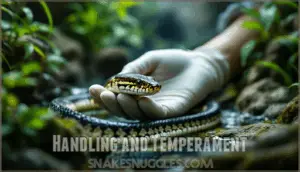This site is supported by our readers. We may earn a commission, at no cost to you, if you purchase through links.

Many beginner-friendly species stay under two feet long and require minimal temperature gradients, making them perfect candidates for smaller habitats. Rosy boas, Kenyan sand boas, and rubber boas all fit comfortably in 10-gallon tanks while offering decades of companionship.
Understanding which species work best in limited space helps you create a thriving environment where your snake won’t just survive, but genuinely flourish.
Table Of Contents
- Key Takeaways
- Suitable Snake Species
- Tank Setup Requirements
- Feeding and Nutrition
- Handling and Temperament
- Health and Care
- Frequently Asked Questions (FAQs)
- What snakes live in a 20 gallon tank?
- Can a snake fit in a 10 gallon tank?
- Which snakes make good apartment pets?
- What snakes live in small enclosures?
- What reptiles can you get in a 10 gallon tank?
- Are worm snakes good for a 10 gallon tank?
- Can a snake live in a 10 gallon?
- What is the best reptile for a 10 gallon tank?
- What is the best pet for a 10 gallon tank?
- What animal can live comfortably in a 10 gallon tank?
- Conclusion
Key Takeaways
- Several small snake species—including rosy boas, Kenyan sand boas, and rubber boas—stay under three feet long and thrive permanently in 10-gallon tanks when given proper heating gradients, appropriate substrate, and secure hiding spots.
- Success depends on matching species to enclosure size rather than forcing larger snakes into inadequate space, since these compact species actually prefer the security of cozy environments over sprawling habitats.
- Essential tank setup requires a temperature gradient (88-92°F basking zone, 75-80°F cool side), 2-4 inches of moisture-retaining substrate like cypress mulch, two hides positioned at different temperature zones, and daily fresh water monitoring.
- Feeding schedules vary significantly by age—hatchlings need meals every 5-7 days while adults only require feeding every 10-14 days using frozen-thawed prey sized no wider than the snake’s body to prevent regurgitation and obesity.
Suitable Snake Species
Looking for a snake that’ll thrive in a 10-gallon tank? You’ve got solid options. The rosy boa stays manageable at 18–46 inches, lives 20–25 years, and behaves well—perfect for first-time snake owner advice. Male Kenyan sand boas hit just 20–24 inches with docile temperaments, though boa size matters since females outgrow this setup. Rubber boas max out around 33 inches, preferring cooler temps and offering beginner-friendly calm. Green snakes reach only 14–20 inches but need vertical enclosure enrichment.
These snakes are often chosen because of their docile and gentle nature. When choosing the right pet snake, consider temperament variety and species lifespan—these small snake species deliver decades of companionship when matched to proper 10-gallon tank recommendations.
Tank Setup Requirements
Setting up a 10-gallon tank correctly makes all the difference in keeping your snake healthy and comfortable. You’ll need to focus on three essential elements: proper heating and lighting, appropriate substrate with hiding spots, and a reliable water source.
Let’s break down each component so you can create the ideal home for your new pet.
Heating and Lighting
Getting heating and lighting right makes all the difference for your snake’s health. Small snakes need a temperature gradient—think warm basking zones around 88–92°F and cooler spots at 75–80°F. This temperature regulation lets them control their body heat naturally. Corn snakes can benefit from low intensity UVB to mimic their natural environment.
Here’s what you’ll need:
- Heating equipment like a heating pad (keep it under 90°F) or ceramic heat emitters for consistent warmth
- Lighting cycles of 12 hours on, 12 hours off to mimic natural day-night rhythms
- Energy efficiency through thermostats that maintain temperatures within ±1°F while cutting overheating risks
- Calibration practices using digital thermometers at both ends weekly—they’re far more accurate than analog versions
Skip incandescent light bulbs for heat; they waste energy and create hotspots. Instead, pair heating and lighting functions separately for better control.
Substrate and Hides
Your snake’s comfort hinges on substrate selection and hides done right. Substrate depth of 2–4 inches works best—enough for burrowing without trapping stale air. Cypress mulch and coconut coir are solid substrate options that boost humidity by 10–30% through natural moisture retention.
For hides, you need two per tank: one warm-side, one cool-side. This setup lets your snake thermoregulate properly while feeling secure. Hide materials matter too—PVC or resin options show 30% less bacterial growth than porous cork. Keep hides snug (about 1.2 times your snake’s body width) so they can touch the sides without getting squeezed.
| Substrate Type | Moisture Retention | Best For |
|---|---|---|
| Cypress Mulch | 7–10 days | Humidity control, burrowing species |
| Coconut Coir | 8–9× dry weight | High-humidity setups, easy cleaning |
| Aspen Shavings | Low | Dry-climate snakes, budget-friendly |
| Bioactive Mix | Extended (with cleanup crew) | Low-maintenance, natural cycling |
Bioactive setups with isopods extend substrate longevity by 200–300%, cutting your cleaning frequency to spot-checks every 3–5 days. Substrate and hides work together to create that secure, stable environment your snake needs to thrive.
Water Source
Fresh water is essential for maintaining the health of your snake in a 10-gallon tank setup. The size of the water dish is important; aim for a diameter of 3–4 inches to allow your snake to soak during shedding without increasing humidity above 60%. Water quality is also crucial—let tap water sit for 24 hours to dechlorinate, or use bottled spring water if your area has hard water exceeding 250 ppm. Due to your snake’s drinking habits, daily refills are necessary, and soaking times before shedding can range from 6–12 hours. Regular cleaning is vital to prevent bacterial growth, which can reduce the risk of mouth rot by 60%. Spot-clean the tank daily and perform a deep clean weekly.
- Position the dish on the cool side to prevent rapid evaporation and bacterial spikes
- Change water every 2–3 days minimum to stop algae and contamination
- Choose a bowl your snake can fully enter without tipping or overflowing
- Rinse thoroughly after cleaning to eliminate soap residue that irritates skin
Feeding and Nutrition
Feeding your snake the right food at the right time keeps it healthy and thriving in a 10-gallon setup. Different species have different dietary needs, so you’ll want to match prey size and type to your snake’s requirements.
Let’s look at what to feed and how often to do it.
Prey Types
Most snakes in a 10-gallon tank thrive on rodent-based diets, but it’s essential to match prey items to your snake’s natural preferences. Frozen-thawed mice are the safest option, reducing the risk of injury by 15–25% compared to live prey. Some species, like garter snakes, prefer fish or earthworms instead.
Here’s a quick breakdown:
| Prey Type | Best For | Key Benefit |
|---|---|---|
| Frozen-thawed mice | Corn snakes, rosy boas | Retains 95% nutrition, safer |
| Fish/earthworms | Garter snakes, ribbon snakes | Matches natural diet |
| Quail eggs | African egg-eaters | Specialized nutritional needs |
Choose prey size no wider than your snake’s thickest body section. Rodent alternatives work well for species with specialized diets, but thiamine supplements are necessary if feeding fish regularly.
Feeding Schedule
Your snake’s age determines how often you’ll feed, and getting this right prevents regurgitation and obesity. Young snakes grow fast and need frequent meals, while adults can go longer between feedings. Age-based frequency varies, but prey size ratio matters just as much—never exceed the snake’s widest girth.
Watch behavior indicators—refusal may signal stress, not illness. Feeding safety improves with pre-killed prey and tong-feeding.
- Hatchlings (under 1 year): Feed every 5–7 days with appropriately sized frozen-thawed mice
- Juveniles (1–2 years): Feed every 7–10 days as metabolism slows
- Adults (over 2 years): Feed every 10–14 days for maintenance
- Seasonal modifiers: Reduce frequency during shedding or breeding cycles
Handling and Temperament
Your snake’s temperament determines how smoothly handling sessions will go, and patience is key during the taming process.
Different species have different comfort levels with human interaction, so understanding what to expect helps you build trust safely.
Let’s look at how to approach taming and what behaviors you’ll likely encounter.
Taming Process
Think of taming like teaching trust—it’s a slow dance, not a race. Your snake needs a 7–14 day acclimation period before you even touch it.
Start with visual desensitization, spending an hour daily near the tank. When ready, use touch gradients: begin at the tail, never the head.
Build a handling schedule of 10–30 minutes daily, reading body language carefully—coiling tight means back off. Positive conditioning through gentle handling drops aggression 60% in three weeks.
Snake Behavior
Reading your snake is like learning a new language—body cues tell you everything. Snakes display fascinating activity patterns shaped by environmental enrichment and seasonal rhythms. Understanding snake body language and respecting solitary social interaction needs builds trust. Snake behavior and environment are deeply connected, so proper handling reduces stress and strengthens your bond with consistent, gentle care.
Watch for these behaviors:
- Exploration through tongue-flicking to map scents and navigate their space, especially during natural activity peaks.
- Defensive signals like tight coiling, hiding, or musking when stressed—captive stress indicators you shouldn’t ignore.
- Recognition and routine learning, showing intelligence beyond simple instinct.
Health and Care
Your snake’s health depends on recognizing early warning signs and staying ahead of problems. Knowing what to expect during shedding and which health issues to watch for helps you keep your pet thriving in its 10-gallon home.
Let’s cover the essentials you’ll need to manage.
Shedding Process
Your snake will shed every 3-6 weeks when young, signaling the start of ecdysis with cloudy eyes and dull skin. Shedding indicators like reduced appetite appear 4-7 days before the snake skin shedding process begins.
Humidity impact is critical—maintain 65-75% to prevent dysecdysis, which affects 30% of captive snakes. If spectacle retention or shedding problems occur, soak your snake in lukewarm water for 10-15 minutes. Dysecdysis remediation restores normal snake health within 24 hours.
Potential Health Issues
Your snake’s well-being depends on catching problems early. Respiratory infections develop when temperatures drop too low, while parasitic infestations from mites cause constant irritation.
Watch for these common health issues:
- Infectious stomatitis (mouth rot) appearing as inflamed tissue or cheesy deposits
- Digestive disorders like regurgitation or bloating from improper feeding schedules
- Skin complications including scale rot from dirty substrate or shedding problems
Seek veterinary care immediately if you notice wheezing, lethargy, or unusual behavior—early treatment prevents minor issues from becoming life-threatening.
Frequently Asked Questions (FAQs)
What snakes live in a 20 gallon tank?
A 20-gallon tank works well for Corn Snakes, Kenyan Sand Boas, Rosy Boas, Western Hognose, and African House Snakes.
These small snakes stay under 2-4 feet, making them ideal beginner snakes with manageable care needs and docile temperaments.
Can a snake fit in a 10 gallon tank?
While large adult pythons can’t call a 10-gallon home, certain small snakes can. Male Kenyan Sand Boas stay under 12 inches, making them lifelong residents. Juvenile corn snakes and milk snakes work temporarily before needing upgrades as they grow.
Which snakes make good apartment pets?
You’ll want corn snakes, ball pythons, or rosy boas for apartment living. These beginner-friendly, apartment-friendly breeds stay small (2-5 feet), produce no noise, handle space limitations well, require minimal odor control, and thrive as pet snakes for first-time snake owners in compact setups.
What snakes live in small enclosures?
You can keep several beginner-friendly species in compact enclosures. Kenyan sand boas reach 2-3 feet and thrive in 10-20 gallon tanks, while rosy boas grow similarly small with a 20-year lifespan, making them suitable snake species for limited space.
What reptiles can you get in a 10 gallon tank?
You can keep several reptiles in a 10-gallon tank, including leopard geckos, crested geckos, house geckos, green anoles, and small snake species like Kenyan sand boas.
These options offer first-time snake owners and beginner reptile enthusiasts species diversity with proper enclosure enrichment.
Are worm snakes good for a 10 gallon tank?
Think of worm snakes as nature’s tiny underground explorers—these small snake species are perfect for a 10 gallon tank. Their burrowing behavior and compact size make them ideal, though their nocturnal activity patterns and shy temperament mean they’re better suited for observation than handling.
Can a snake live in a 10 gallon?
Yes, some snakes can live in a 10-gallon tank, but only specific small species. Rosy Boas, Kenyan Sand Boas, and Worm Snakes stay under 3 feet and manage well in this enclosure size throughout their lives when proper care is provided.
What is the best reptile for a 10 gallon tank?
Leopard geckos thrive in 10-gallon tanks and live 10-20 years with proper care. These docile lizards are beginner-friendly reptiles that need minimal space.
However, for snake enthusiasts, small snake species like Kenyan sand boas offer similar manageability in compact enclosures.
What is the best pet for a 10 gallon tank?
A 10-gallon tank works well for compact snake species like Rosy Boas, Kenyan Sand Boas, or male African House Snakes.
These beginner-friendly snakes stay manageable in size, adapting comfortably to smaller enclosures with proper enrichment and care.
What animal can live comfortably in a 10 gallon tank?
A 10-gallon tank can comfortably house small snake species like rosy boas, milk snakes, or garter snakes. These reptiles stay compact as adults—usually under two feet—and thrive with basic heating, hiding spots, and weekly feedings, making them ideal for beginners managing limited enclosure space.
Conclusion
While massive enclosures impress visitors, the best pet snakes that can live in a 10 gallon tank prove bigger isn’t always better. These compact species don’t just tolerate smaller spaces—they actually prefer the security of cozy environments.
Your success hinges on species selection, not tank size. Choose a rosy boa or Kenyan sand boa, maintain proper heating gradients, and you’ll watch your snake thrive for decades in a space that fits any apartment.
- https://a-z-animals.com/animals/snake/snake-facts/pet-snakes-that-stay-small/
- https://www.youtube.com/watch?v=kCxviaueMtI
- https://eadn-wc03-6543712.nxedge.io/wp-content/uploads/thermoregulation.pdf
- https://www.visionproducts.us/blog/reptile-temperature/
- https://www.zenhabitats.com/blogs/reptile-care-sheets-resources/corn-snake-complete-lighting-and-heating-guide












